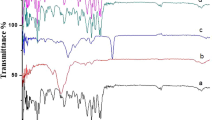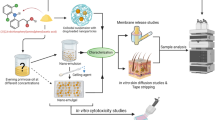Abstract
A transdermal preparation containing diclofenac diethylammonium (DDA) was developed using an O/W microemulsion system. Of the oils tested, lauryl alcohol was chosen as the oil phase of the microemulsion, as it showed a good solubilizing capacity and excellent skin permeation rate of the drug. Pseudoternary phase diagrams were constructed to obtain the concentration range of oil, surfactant and cosurfactant for microemulsion formation, and the effect of these additives on skin permeation of DDA was evaluated with excised rat skins. The optimum formulation of the microemulsion consisted of 1.16% of DDA, 5% of lauryl alcohol, 60% of water in combination with the 34.54% of Labrasol (surfactant)/ethanol (cosurfactant) (1:2). The efficiency of formulation in the percutaneous absorption of DDA was dependent upon the contents of water and lauryl alcohol as well as Labrasol:ethanol mixing ratio. It was concluded that the percutaneous absorption of DDA from microemulsions was enhanced with increasing the lauryl alcohol and water contents, and with decreasing the Labrasol:ethanol mixing ratio in the formulation.
Similar content being viewed by others
References
Barry, B. W., The LPP theory of skin penetration enhancement. In Bronaugh, R. L. and Maibach, H. I. (Eds),In Vitro Percutaneous Absorption: Principles, Fundamentals, and Applications. CRS Press, Orlando, Florida, pp. 165–185 (1991).
Cappel, M. J. and Kreuter, J., Effect of nanoparticles on transdermal drug delivery.J. Microencapsul., 8, 369–374 (1991).
Delgado-Charro, M. B., Iglessias-Vilas, G., Blanco-Mendez, J., Lopez-Quintela, M. A., Marty, J. P., and Guy, R. H., Delivery of hydrophilic solute through the skin from novel microemulsion systems.Eur. J. Pharm. Biopharm., 43, 37–42 (1997).
Fevrier, F., Bobin, M. F., Lafforgue, C., and Martini, M. C., Advances in microemulsions and transepidermal penetration of tyrosine.STP Pharm. Sci., 1, 60–63 (1991).
Gallarate, M., Gasco, M. R. and Trotta, M., Influence of octanoic acid on membrane permeability of timolol from solutions and from microemulsions.Acta Pharm. Technol., 34, 102–105 (1988).
Hofland, H. E. J., Bouwstra, J. A., Spies, F., Gooris, G., and Junginger, H. E., Interaction between liposomes and human skin in vitro: Poster presentation. Conference: Liposomes in Drug Delivery 21 years On, London, 12–15 (1990).
Iwamoto, K., Kato, T., Kawahara, M., Koyama, N., Watanabe, S., Miyake, Y., and Sunamoto, J., Polysaccharide-coated oil droplets in oil-in-water emulsions as targetable carriers for lipophilic drugs.J, Pharm. Sci., 80, 219–224 (1991).
Iwasa, A., Irimoto, K., Kasai, S., Okuyama, H., and Nagai, T., Effect of nonionic surfactants on percutaneous absorption of diclofenac sodium.Yakuzaigaku, 51, 16–21 (1991).
Kemken, J., Ziegler, A., and Muller, B. W., Investigations into the pharmacodynamic effect of dermally administered micro-emulsions containing β-blockers.J. Pharm. Pharmacol., 43, 679–684 (1991).
Knepp, V. M., Szoka, F. C., Jr and Guy, R. H., Controlled drug release from novel liposomal delivery system: II. Transdermal delivery characteristics.J. Control. Rel., 12, 25–30 (1990).
Lasch, J., Laub, R., and Wohlarab, W., How deep do intact liposomes penetrate into human skin.J. Control. Rel., 18, 55–58 (1991).
Loth, H., Vehicular influence on transdermal drug penetration.Int. J. Pharm., 68, 1–10 (1991).
Menasse, R., Hodwall, R., Kractz, P. R., Pericin, J., Riester, C., Sallmann, L., Ziel, A., and Jaque, R.,Scand. J. Rheumatol. Suppl., 22, 5–16 (1978).
Naito, S. and Tominaga, H., Percutaneous absorption of diclofenac sodium ointment.Int. J. Pharm., 24, 115–124 (1985).
Nannipieri, E., Carelli, V., Dicolo, G., Giorgi, I., and Serafini, M. F., Vehicle influence on the permeation of highly lipophilic molecule. Anin vitro technique to evaluate skin-vehicle interactions.Int. J. Cosmet. Sci., 12, 21–31 (1990).
Nishihata, T., Kotera, K., Nakano, Y., and Yamazaki, M., Rat percutaneous transport of diclofenac and influence of hydrogenated soya lecithin.Chem. Pharm. Bull., 35, 3801–3812 (1987).
Nishihata, T., Kamada, A., Sakai, K., Takahashi, K., Matsumoto, K., Shinozaki, K., Tabata, Y., Keigami, M., Miyagi, T., and Tatsumi, N., Percutaneous absorption of diclofenac in rats and humans:aqueous gel formulation.Int. J. Pharm., 46, 1–7 (1988).
Obata, Y., Takayama, K., Machida, Y., and Nagai, T., Combined effect of cyclic monoterpenes and ethanol on percutaneous absorption of diclofenac sodium.Drug Design Discovery, 8, 137–144 (1991).
Obata, Y., Takayama, K., Maitani, Y., Machida, Y., and Nagai, T., Effect of ethanol on skin permeation of nonionized and ionized diclofenac.Int. J. Pharm., 89, 191–198 (1993).
Rhee, Y.-S., Choi, J.-G., Park, E.-S., and Chi, S.-C., Transdermal delivery of ketoprofen using microemulsions.Int. J. Pharm., 228, 161–170 (2001).
Takahashi, K., Tamagawa, S., Katagi, T., Yoshitomi, H., Kamada, A., Rytting, J., Nishihata, T., and Mizuno, N.,In vitro transport of sodium diclofenac across rat abdominal skin: Effect of selection of oleaginous component and the addition of alcohols to the vehicle.Chem. Pharm. Bull., 39, 154–158 (1991a).
Takahashi, K., Tamagawa, S., Katagi, T., Yoshitomi, H., Kamada, A., Rytting, J., Nishihata, T., and Mizuno, N.,In vitro percutaneous transport of sodium diclofenac and diclofenac from oleaginous vehicle.Chem. Pharm. Bull., 39, 509–511 (1991b).
Takayama, K., Kikuchi, K., Obata, Y., Okabe, H., Machida, Y., and Nagai, T., Terpenes as percutaneous absorption promoters.STP Pharm. Sci., 1, 83–88 (1991).
Touitou, E. and Fabin, B., Altered skin permation of a highly lipophilic molecule: tetrahydrocannabinol.Int. J. Pharm., 43, 17–22 (1988).
Weiner, N. and Egbaria, K., Topical application of liposomal systems: Poster presentation. Conference: Liposomes in Drug Delivery 21 years On, London, 12–15 (1990).
Windheuser, J. J., Haslam, J. L., Caldwell, L., and Shaffer, R. D., The use ofN,N-diethyl-m-toluamide to enhance dermal and transdermal delivery of drugs.J. Pharm. Sci., 71, 1211–1213 (1982).
Author information
Authors and Affiliations
Corresponding author
Rights and permissions
About this article
Cite this article
Kweon, JH., Chi, SC. & Park, ES. Transdermal delivery of diclofenac using microemulsions. Arch Pharm Res 27, 351–356 (2004). https://doi.org/10.1007/BF02980072
Received:
Issue Date:
DOI: https://doi.org/10.1007/BF02980072




